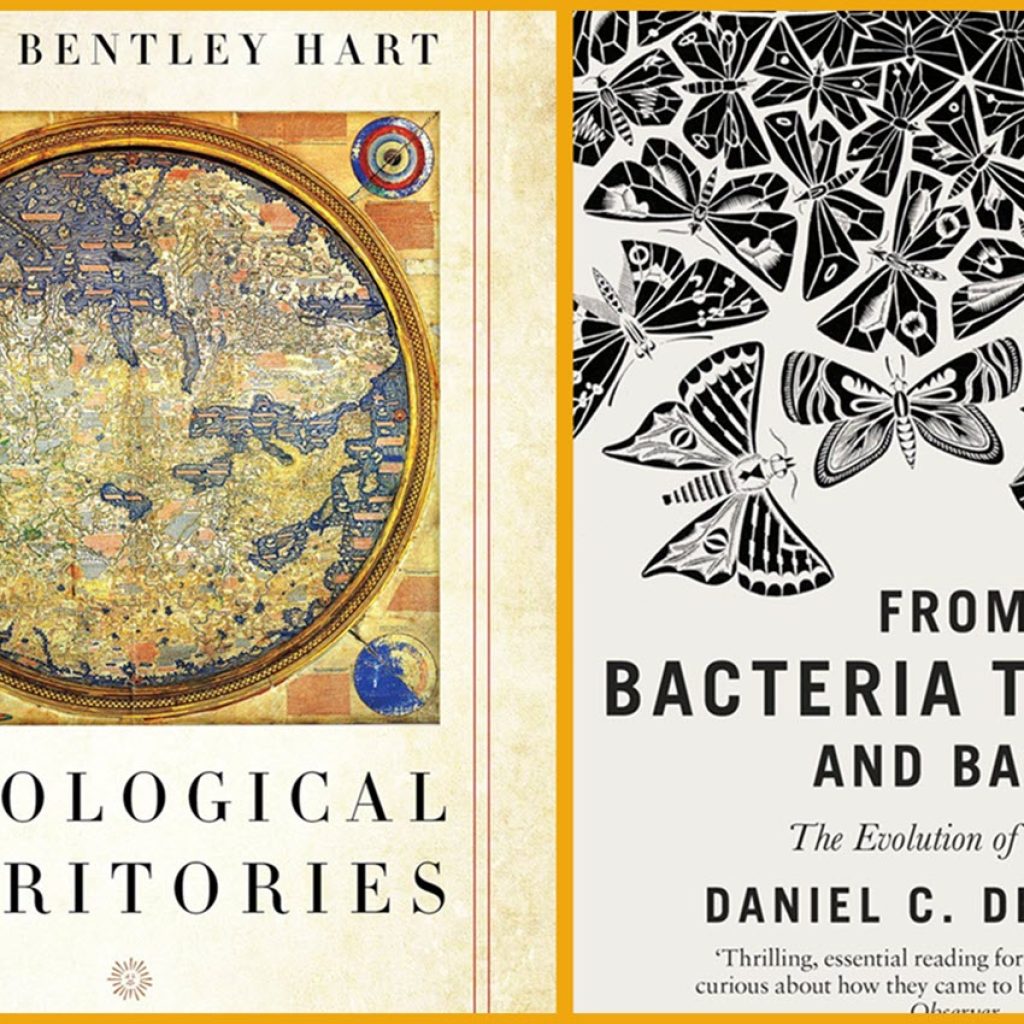A unified field of apprehending joins the unity of consciousness as we navigate Third Person descriptions and First-Person experiences. The following is (in full) a Copy/Paste from the book “Roland In Moonlight” by David Bentley Hart (…Amazon https://www.amazon.com/David-Bentley-Hart/e/B001JRTRC0…). The excerpt is from section/chapter XXV entitled “The Plan For The Book” as DBH ponders a possible approach to a book dealing with these concepts.
Begin Quote/Excerpt [*Note: bold added]
XXV
2: The Plan For The Book
The text, as I now envisage it, will have five major divisions. Part I will be an account of the rise of the “problem of mind” as a result of the early modern triumph of the mechanical philosophy and, in time, of the late modern dominance of the philosophical naturalism that was its inevitable sequel. As inheritors of a picture of reality shaped by this mechanistic metaphysics, we today are confronted by an altogether preposterous dilemma when we attempt to make sense of the reality of unified consciousness or intentional mental acts or a host of other mental phenomena. Within the mechanical narrative, matter is mindless mass, and physical causality mindless force, and so the presence—or apparent presence—within nature of such things as, say, conceptual abstractions or volitions or final purposes creates a theoretical problem that seems to allow of only two possible solutions: either some version of Cartesian dualism (in which the body is a machine centrally operated by an immaterial homunculus called the “soul”) or a thoroughgoing mechanical monism (in which mind is an emergent result or epiphenomenon of unguided physical events). And naturally many materialist philosophers or neuroscientists assume that, if they can only dispose of the Cartesian soul once and for all, they will have by default established the supremacy of the physicalist position; and assume also that to accomplish this they need only find instances in which the brain operates without immediately conscious supervision on the part of any purely rational and cognizant agency within—moments, that is, when the homunculus appears to be asleep at the controls. For then, they imagine, they will have proved that everything, mind included, is only a form of mechanism after all, and no Wonderful Wizard is to be found on the other side of the screen, pulling the levers. The mechanistic paradigms within which they operate condemn them to an inescapable binary choice: if they are not to believe in a ghost mysteriously animating a machine then they must make themselves believe in a machine miraculously generating a ghost.
There is, of course, a history here. The extraordinary fruitfulness of modern scientific method was achieved, before all else, by a severe narrowing of investigative focus; and this involved the willful shedding of an older language of causality that possessed great richness, but that also seemed to resist empirical investigation. The first principle of the new organon was a negative one: the exclusion from scientific investigations of any consideration of possible formal and final causes, and even of a distinct principle of “life,” in favor of an ideally inductive method, supposedly purged of metaphysical prejudices, according to which all natural systems were to be conceived as mere machine processes, and all real causality as exchanges of energy between material masses. Everything physical became, in a sense, reducible to the mechanics of local motion; even complex organic order came to be understood as the purely emergent result of physical forces moving through time from past to future as if through Newtonian space. Everything came to be regarded as ultimately reducible to the most basic level of material existence, and to the mathematically calculable physical consequences of purely physical antecedent causes. And while at first many of the thinkers of early modernity were content to draw brackets around material nature, and to allow for the existence of realities beyond the physical—mind, soul, disembodied spirits, God—they necessarily imagined these latter as being essentially extrinsic to the purely mechanical order that they animated, inhabited, or created. Thus, in place of classical theism’s metaphysics of participation in a God of infinite being and rationality, these thinkers granted room only for the adventitious and finite Cosmic Mechanic or Supreme Being of Deism or (as it is called today) Intelligent Design Theory. And, in place of the spiritual soul of antique thought, they allowed for only Cartesian dualism’s “ghost in the machine.” But, of course, even the constrained ontological liberality of this compromise was unsustainable. Reason abhors a dualism. Any ultimate ground of explanation must be one that unites all dimensions of being in a simpler, more conceptually parsimonious principle, capable of reconciling any apparent antinomies. Soul and body could not continue indefinitely to coexist as utterly distinct principles in only accidental alliance, especially given that only the latter fell within the province of the new strictly inductive sciences. Thus, inevitably, what began as method soon metastasized into a metaphysics, almost by inadvertence. For a truly scientific view of reality, it came to be believed, everything—even mind—must be reducible to one and the same mechanics of motion. Those methodological brackets that had been so helpfully drawn around the physical order now became the very shape of reality itself; beyond them lay, by definition, absolutely nothing.
It was always something of a fantasy, of course. For one thing, even as a method, the mechanical model could extend only so far. Pure induction is an impossible ideal. In the life sciences, for instance, organisms can only very rarely be investigated without any hypothetical appeals whatsoever to purpose, or without treating organic structures as intentional systems; and only metaphysical prejudice dictates that this purposive language is no more than a useful and dispensable fiction. Moreover, before “higher causes” like form and finality could be excised from the grammar of the sciences, they had first to be radically misconstrued. Even such residual Aristotelian terminology as remained in the sciences had already, by the late sixteenth century, been mechanized, so to speak. Form and finality had come to be seen as physical forces or influences extrinsic to a material substrate that in itself was not the pure potentiality of prime matter but merely a universal, subtle, ductile, unarticulated physical substance. The elements of nature were not imagined, as they had been in the classical and mediaeval synthesis, as having an intrinsic disposition toward order or vital integrity; they were seen simply as inert ingredients upon which formal determinations were adventitiously impressed, under the external guidance of final causes that operated merely as factitious designs. And so, seen thus, form and finality soon came to seem not only superfluous suppositions, but little more than features of an inferior and obsolete mechanical model. One cannot, however, really reject something one does not understand.
Neither Aristotle’s concept of an “aitia,” nor any scholastic concept of a “causa,” actually corresponds to what we—following our early modern predecessors—mean when we speak of a “cause.” A better rendering of “aitiai” or “causae,” in the ancient or mediaeval sense, might be “explanations,” “rationales,” “logical descriptions,” or (still better) “rational relations.” The older fourfold nexus of causality was not, that is to say, a defective attempt at modern physical science, but was instead chiefly a grammar of predication, describing the inherent logical structure of anything that exists insofar as it exists, and reflecting a world in which things and events are at once discretely identifiable and yet part of the larger dynamic continuum of the whole. It was a simple logical picture of a reality in which both stability and change can be recognized and designated. And these aitiai or causae were intrinsic and indiscerptibly integral relations, distinct dimensions of a single causal logic, not separated forces in extrinsic relation to one another. A final cause, for instance, was an inherent natural end, not an adventitiously imposed design; and this was true even when teleology involved external uses rather than merely internal perfections (as in the case of human artifacts); it was at once a thing’s internal fullness and its external participation in the totality of nature. In a sense, a causal relation in this scheme is less like a physical interaction or exchange of energy than it is like a mathematical equation, or like the syntax of a coherent sentence. Admittedly, this is a picture of reality that comes from ages in which it was assumed that the structure of the world was analogous to the structure of rational thought. But, then again, this was an eminently logical assumption, if only because there appears to be a more than illusory or accidental reciprocal openness between mind and world, and because the mind appears genuinely able to penetrate the physical order by way of irreducibly noetic practices like mathematics and logic and systematic observation.
Part II will be a consideration of various difficulties that the modern picture of the world creates for the philosophy of mind. Once nature had been reconceived as essentially mindless, precisely through the methodological exclusion of anything analogous to mind from our understanding of the structure of physical reality, the attempt to reintegrate the phenomena of mental life into our picture of nature became entirely hopeless. And once every attempt at physical explanation has been exhausted (see below), only two possible courses appear to remain, both of which are arguably absurd in their own terms: either total eliminativism, according to which consciousness and all its properties are illusions; or a physicalist panpsychism, which understands consciousness as a kind of property simply present in all material states, in varying degrees of cumulative complexity.
Here, I shall begin by making it clear that current neurophysiological attempts to account for mental phenomena—while they may provide an ever more comprehensive and precise catalogue of correspondences between brain events and certain mental states— necessarily fail to disclose any plausible causal connection between those third-person descriptions and those first-person experiences. I shall then address many of the classic impediments to a physicalist philosophy of mind: qualia or qualitative consciousness as such, which is to say first-person sensuous intuition, immediate impressions, and self-awareness; abstract concepts, not only as features of thought, but as the indispensable conditions of thought; language and its irreducible syntactic and semantic properties, which it seems impossible credibly to explain in purely physical evolutionary terms; the syntax and semantics of acts of reason, or of any mental acts whose internal connections appear to be conceptual or logical rather than merely physical; the unified field of experience and thought, which seems impossible to reconcile with the composite nature of physical structures and functions; mental intentionality— intrinsic intentionality, to use the technical term—which for any number of reasons (principally, its irreducibly teleological structure) seems irreconcilable with a mechanical or physicalist account of mind.
This part of the book will also deal with the inadequacy— increasingly acknowledged even by “naturalist” philosophers of mind—of many of the standard attempts to close the gap between physical third-person descriptions and first-person descriptions of consciousness and thought. Often, in fact, these attempts at explanation turn out simply to be ways of restating the problem without solving it, as is the case with most theories of “supervenience.” At other times, they simply reduce first-person phenomena to irrelevancy without actually explaining anything, as in the case of “epiphenomenalism.” Sometimes, they are simply defective analogies, based on basic category errors, as in the case of “computational” models of mind. And, in general, there seems as yet to be nothing approaching a coherent account of how mental phenomena emerge from physical events (however closely associated with those events they may be).
In part, this is because of the inherently nebulous nature of the very concept of “emergence” or “emergent properties” as it is used in the sciences today, in either evolutionary biology or neuroscience. All too often, talk of “emergence” merely provides a convenient way of evading problems without appearing to have done so. It is, admittedly, a beguilingly simple idea—the notion that there are in nature composite realities whose peculiar properties and capacities emerge from the interaction of their elements, even though these properties and capacities do not reside in those elements themselves. An emergent whole, in other words, is more than—or at any rate different from—the sum of its parts; it is not simply the consequence of an accumulation of discrete powers added together in a sum, but the effect of a specific ordering of relations among those powers that produces something entirely new within nature. And this idea is quite true in a general sense; but it is also a limited truth in many crucial senses. For, if it is to close the devilish explanatory gap between mechanism and mind, the model of emergence employed must somehow entail the appearance of new physical realities that, even though they remain dependent upon the native properties of the elements composing them, nevertheless possess characteristics entirely irreducible to those properties. But this makes no sense. At least, as a claim made solely about physical processes, organisms, and structures in purely material terms it cannot possibly be true. From a physical perspective, emergent properties cannot be discontinuous from the properties of the prior causes from which they arise; anything, in principle, must be reducible, by a series of “geometrical” steps, to the physical attributes of its ingredients. Water, for example, is composed of two very combustible gaseous elements, hydrogen and oxygen, and yet it possesses the novel property of liquidity and a capacity for extinguishing fire. But, while these new properties are not identical with any properties resident in either hydrogen or oxygen molecules, they are most definitely reducible to those special molecular properties that, in a particular combination, cause hydrogen and oxygen to negate one another’s combustible propensities and gaseous structures. So long as this is all that is meant by “emergence,” then the concept is as inoffensive as it is obvious.
Problems arise, however, when the concept is asked to explain away causal gaps in nature that more closely resemble the difference between, say, the physical elements from which a computer is composed and that computer’s functions. True enough, a computer is composed wholly of silicon, metal, plastic, electrical impulses, and so forth, and yet its operations are not only not present in any of its discrete parts, but are qualitatively different from any mere aggregation of the properties of those parts. But this is because a computer’s functions do not emerge from its physical ingredients at all. What distinguishes its powers from those individually possessed by its various material elements is not any emergent property, but rather the causal influence of a creative intellect acting upon those elements from without. So, while it is true that nothing that characterizes a computer physically is anything more than a mathematically predictable result of certain physical antecedents, those operations that actually involve computing in the full sense have been imposed upon the computer’s physical constituents by a further, more eminent, formal causality (itself directed by a final causality). At the purely material level, whatever is truly emergent is also reducible to that from which it emerges; otherwise, “emergence” is merely the name of some kind of magical transition between intrinsically disparate realities.
Hence, as I have said, the two most extreme options for dealing with the problem of mind in the terms provided by the modern metaphysics of nature—total eliminativism and physicalist panpsychism—are really the only ones not precluded by the limits of the logic of emergence. But both, alas, suffer from conceptual and logical problems of their own. Eliminativism asks us to entertain the idea that consciousness can be an illusion despite the phenomenologically verifiable reality of consciousness as normally conceived, and despite the inconvenient reality that an “illusion of consciousness”—being an intentional state embraced within a unified field of apprehension and experienced by a self-aware affective subject— would have to be a “consciousness of illusion.” Logical circles tend not to advance one’s argument. Panpsychism, meanwhile, understood as a purely physicalist (rather than classically idealist) doctrine, answers no questions; it merely defers the question to the subatomic level, in the vain hope that it may grow so very small that it will vanish away altogether. But we end up with the same paradox: one and the same atom (say) possesses two contradictory aspects, each of which is the logical inversion of the other—in Kantian terms, the nomological and the pathological. One side of the thing (that bound by physical laws) is mechanistic and empirical, the other (that possessed of qualitative awareness) is teleological and transcendental. The interaction between the two sides is no less mysterious for being atomized. And this is no less true when panpsychism is supplemented by the quantitative “science” of Integrated Information Theory (as proposed by Giulio Tononi). There is, moreover, the not inconsiderable problem that consciousness is not really a “property” in any coherent sense, the way that mass or velocity is: an invariant “fact about” a discrete substance or event that may have different effects (in the case of mass, for instance, according to the degree to which it is subject to gravity), but that is otherwise simply another way of describing that substance or event. Consciousness is nothing like that. It exists not as a quality or mode or accident of something else, but only and always as a specific kind of act, phenomenologically describable but not reducible to any physical or intrinsic “state” apart from the activity itself. It exists, that is, as a kind of agency, which is to say that every event of consciousness is an action attributable to an agent. This consideration leads to:
Part III, which will attempt to ask the question of mind anew, this time from a more properly phenomenological point of departure. If we begin from an entirely unprejudiced examination of mental acts—what consciousness “does,” how intentionality “works,” how unity and diversity become manifest within the mind’s “field” of operation, and so forth—we find that there is no clear boundary between the contours of the mind’s operations and those of the world as it appears within consciousness. The conditions necessary for knowledge of the world and the conditions necessary for the world’s existence as an object of knowledge at any number of vital points seem insensibly to merge into a single reality. Most striking in this regard is the way in which the world, as perceived under the conditions of the mind’s necessary unity of apprehension, depends upon the mind’s constant intentional reference to a final horizon of intelligibility that can be characterized only as transcendental. Neither that simplicity nor that ultimacy is a reality that can be found within nature as a closed totality, and certainly neither appears consistent with any physicalist theory of the world; and yet only by virtue of both realities at once, in indissoluble unity with one another, does nature have any kind of comprehensible existence for us as a phenomenon available to the intending intellect. It is only between these two indispensable and enduring extra-natural poles—the unity of the apprehending mind, the transcendental finality of the intending mind—that nature takes shape as a distinct reality, at once infinitely diverse and irreducibly unified. Every movement of the conscious and intending mind toward any finite end is an act at once of recognition, evaluation, judgment, and choice, all of which are possible for the mind by virtue of its own more primordial, more tacit, more unremitting preoccupation with that transcendental horizon that gives all finite things their meanings and their identities for us. All the objects and moments of experience, and all their relations and disjunctions and coordinations and successions, and every meaning, conceptual possibility, or purpose attaching to them are available to the mind only as embraced within and illuminated by that anticipation of the ultimate object of desire (the good, the true, the beautiful…). And that horizon, obviously enough, consists in a set of abstract perfections that are, as absolute objects of the rational will, at once both noetic and ontological. They are, to revert to the terms of a very venerable metaphysical tradition, the “names of God”: words used to indicate (but not, certainly, describe) the most original and most ultimate ground of reality, which is at once infinite being and infinite mind. One need not believe, I imagine, that these concepts have an actual objective reference; but, even so, one must recognize that our minds possess a world that can be experienced, interpreted, and understood only in and by their implicit and inexhaustible engagement with a supernatural order of meaning. This being so, it seems only rational to grant that the reality of such an order would at the very least provide us with an explanation for the curious and otherwise inexplicable fact of the transparency of mind and world to one another. If, after all, that were nothing but an extrinsic relation, some kind of fortuitous harmony, then it would constitute the most remarkable—and yet the most ubiquitous and constant—coincidence of qualitative incommensurables imaginable. Why, then, ought we assume any real causal discontinuity between the world’s being and the mind’s knowing of the world? At some point, surely, it becomes impossible not to wonder whether the only properly empirical approach to the question of mental reality should begin with a radically different kind of methodological bracketing: one that suspends every presupposition regarding a real distinction between epistemology and ontology.
At least, we should never simply assume that being and consciousness are ever truly severable from one another. Could something exist, for instance, in such a manner that it could not be perceived or thought about in any way at all, not even by itself, even in principle? In what sense would it be distinct from absolute nothingness? It certainly seems reasonable to say that being is manifestation, that real subsistence is revelation, that to exist is to be perceptible, conceivable, knowable—and that, moreover, to exist fully is to be manifest to consciousness. If there were a universe in which consciousness did not exist, in what sense precisely would that universe itself exist? Certainly not as a fully articulated spatial and temporal reality filled with clearly discrete objects, like the universe that exists in our minds. The reality we find present in our thoughts, in which intensities and densities and durations and successions are arranged in such magnificently complex but diverse order, exists only relative to consciousness; at the phenomenal level—the level of reality as it appears to intentional awareness—nothing would exist at all. In itself, if it had any reality in itself, this “mindless” universe would be only a plenum or totality of indeterminate quantum potentialities. It would be something quite different from the extended reality of space and time known to us. Even then, it seems fair to say that if such a universe did in some sense exist, it would do so exactly to the extent that it could be known to consciousness of some kind. There is no such thing as ontological coherence that is not a rational coherence. There is a point then, arguably, at which being and intelligibility become conceptually indistinguishable. It is only as an intelligible order, as a coherent phenomenon, that anything is anything at all, whether an elementary particle or a universe; perhaps it is true that only what could in principle be known can in actuality exist. So, at any rate, we have to believe. The rational desire to know the truth of things, in every sphere, is sustained by a tacit faith in some kind of ultimate coincidence or convertibility between being and consciousness. That natural orientation of the mind toward a horizon of total intelligibility mentioned above—that natural intellectual appetite for truth— requires us to venture all our labors of understanding on the assumption that rational thought and coherent order are two sides of a single reality, or at least somehow naturally fitted to one another. If we believe that the structure of reality can truly be mirrored in the structure of our thinking, then we must also believe that there is an ideal or purely intelligible dimension of reality that really corresponds to the categories and concepts that allow us to understand the world. We must believe that being in itself is pure intelligibility.
Part IV will take this line of reasoning perhaps as far as it can go and attempt to demonstrate that every act of conscious, unified, intentional mind is necessarily dependent upon infinite mind— which is to say, God. If the argument of Part III is correct, then the whole of what we know as nature appears in the interval between two transcendental realities: the apperceptive unity of intentional consciousness and the teleological universality of being as total intelligibility. This is the structure of thought; and so the whole world of nature occurs between two poles that cannot be fitted within the naturalist picture. As Part II has argued, the logical and ontological priority of neither pole admits of a materialist solution, even though the material order is constituted as an intelligible totality only by the relation between them. Thus the physicalist continuum is broken open at both ends, experience of the “natural” proves to be the gift of “super-natural” knowledge, and a certain set of metaphysical questions inevitably pose themselves. Chiefly, we should ask whether this ordo cognoscendi [order of knowing] must be (as one ancient deduction of reason insists) an inversion of the ultimate ordo essendi, [order of being] and whether this relation between subjective unity of consciousness and its (gnoseological) end in the fullness of transcendent being is a glimpse—caught in the looking glass of rational reflection—of the real relation between transcendent being as original source and the subject as its (ontological) end.
If in fact world and mind really are open to one another in this way, then once more it seems we should accord a certain causal priority to mind over matter in our picture of reality. If the materialist understanding of nature were essentially correct, it would be difficult enough to account for the existence of consciousness; but it would be far more difficult still to say how consciousness, in all its exorbitant difference from the purposeless welter of physical causality, could actually capture the truth of physical reality in the exquisite trammels of its concepts. Yet it certainly seems that, in abstracting experience into various kinds of ideal content—formal, mathematical, moral, aesthetic, and so on—the mind really does extract knowledge from what would otherwise be nothing but meaningless brute events. In fact, reality becomes more intelligible to us the more we are able to translate it into purely mental concepts, and to arrange it under categories, and then to arrange our concepts under ever simpler, more comprehensive, more unconditioned concepts, always ascending towards the simplest and most capacious concept our minds can reach. To say that something has become entirely intelligible to us is to say that we have an idea of it that is both comprehensively simple as an explanatory principle and that also leaves no empirical or conceptual remainder behind. It is to say, in accord with so much classical and mediaeval thought, that the ideal and intrinsically intelligible dimension of things is not only a real property of their existence, but in some sense is identical with their existence.
What is an idea, however, other than the expression of a rational intentionality? And how, therefore, could being be pure intelligibility if it were not also pure intelligence? Surely, something has to be said for Bernard Lonergan’s famous argument that the “unrestricted intelligibility” of reality leads thought to God as the one “unrestricted act of understanding.” As the mind moves towards an ever more comprehensive and “supereminent” grasp of reality, it necessarily moves towards an ideal level of reality at which intelligibility and intelligence are no longer distinguishable: for what is the ideal other than the known? The mind can be a true mirror of objective reality because we assume that objective reality is already a mirror of mind. The ascent towards ever greater knowledge is, if only tacitly, an ascent towards an ultimate encounter with limitless consciousness, limitless reason, a transcendent reality where being and knowledge are always already one and the same, and so inalienable from one another.
Perhaps, then, the best definition of mind is “a restricted instance of that unrestricted act”: like light captured in and refracted by a prism, being—which is consciousness—expresses itself in the faceted finitude of our natures. But it is God in himself who is the logical order of all reality, the ground both of the subjective rationality of mind and the objective rationality of being, the transcendent and indwelling Reason or Wisdom by which mind and matter are both informed and in which both participate. If indeed to exist is to be manifest—to be intelligible and perceptible—and if to exist fully is to be consciously known, then God, as infinite being, is also an act of infinite knowledge. He is in himself the absolute unity of consciousness and being, and so in the realm of contingent things is the source of the fittedness of consciousness and being each to the other, the one ontological reality of reason as it exists both in thought and in the structure of the universe. Thus, when one looks inward, towards that vanishing point of unity that makes the whole of mental life possible, one looks—as all contemplative traditions insist—towards the source and ground of the mind, the simplicity of God, the one ground of both consciousness and being. More inward to consciousness than consciousness itself is that scintilla or spark of divine light that imparts life and truth to the soul; and the mind’s interior journey towards its own wellspring brings it to a place where it finds itself utterly dependent upon the sublime simplicity of God’s knowledge of all things in his knowledge of himself. And thus also, when one looks outward, towards the world, one looks towards that same source, that same unity of being and intelligibility. So, whether one looks outward or inward, the soul looks upon the soul; or, to say the same thing from the opposite angle, being looks upon being; and thus—in either case—one encounters God in his self-disclosure.
In short, the structure of all thought is a relation of the mind to God. In fact, teleologically considered, the mind is God, striving not only to see—but to become—infinite knowledge of infinite being, beyond any distinction between knower and known. Which may be one way of saying that, as the Māṇḍūkya Upaniṣad tells us, Ayam Ātmā Brahma: Ātman is Brahman. It may be that this is the first and most obvious of the truths of reason.
Thus Part V will argue that the only “science of mind” that could actually disclose the nature of the mental in its own intrinsic aspect would be something like the contemplative discipline proper to the great mystical traditions of the world’s religions. There can be no real science of mind that is not, in fact, a spiritual science. This part of the text, however, I cannot really summarize, except to say that it will draw on Christian, Jewish, Muslim, Hindu, Buddhist, Platonist, and other contemplative sources to describe the real experience of a final coincidence of being and knowing in God or the transcendent ground of all: the experience, that is, of that place where “Hie ist gotes grunt mìn grunt unde mìn grunt gotes grunt” (as Eckhart says), and where nous finds itself at home in its divine source (as Plotinus says), and where one knows God to be at once interior intimo meo and superior summo meo (as Augustine says), and where delimited being (al-wujûd al-muqayyad) returns to its wellspring in the Nondelimited Being (al-wujûd al-mutlaq) of the divine light (as ibn Qunawi says), and where the “secret soul” (ruh sirr) within us is revealed as the eternal breath (ruh) of God, breathed into us in creation. It is here that the unity of mind, in its teleological co-extensiveness with all of reality, meets the unity of being, and we discover that the irreducibility of mind to physical causes and the irreducibility of being to physical events are one and the same irreducibility.
End Quote/Excerpt [*Note: bold added]
Related: Consciousness, Emergence, Intentionality, Searle, Reason Atop The Irrational, And Naturalism’s Egregious Deficiency https://metachristianity.com/consciousness-emergence-intentionality-searle-reason-atop-the-irrational/






No comment yet, add your voice below!